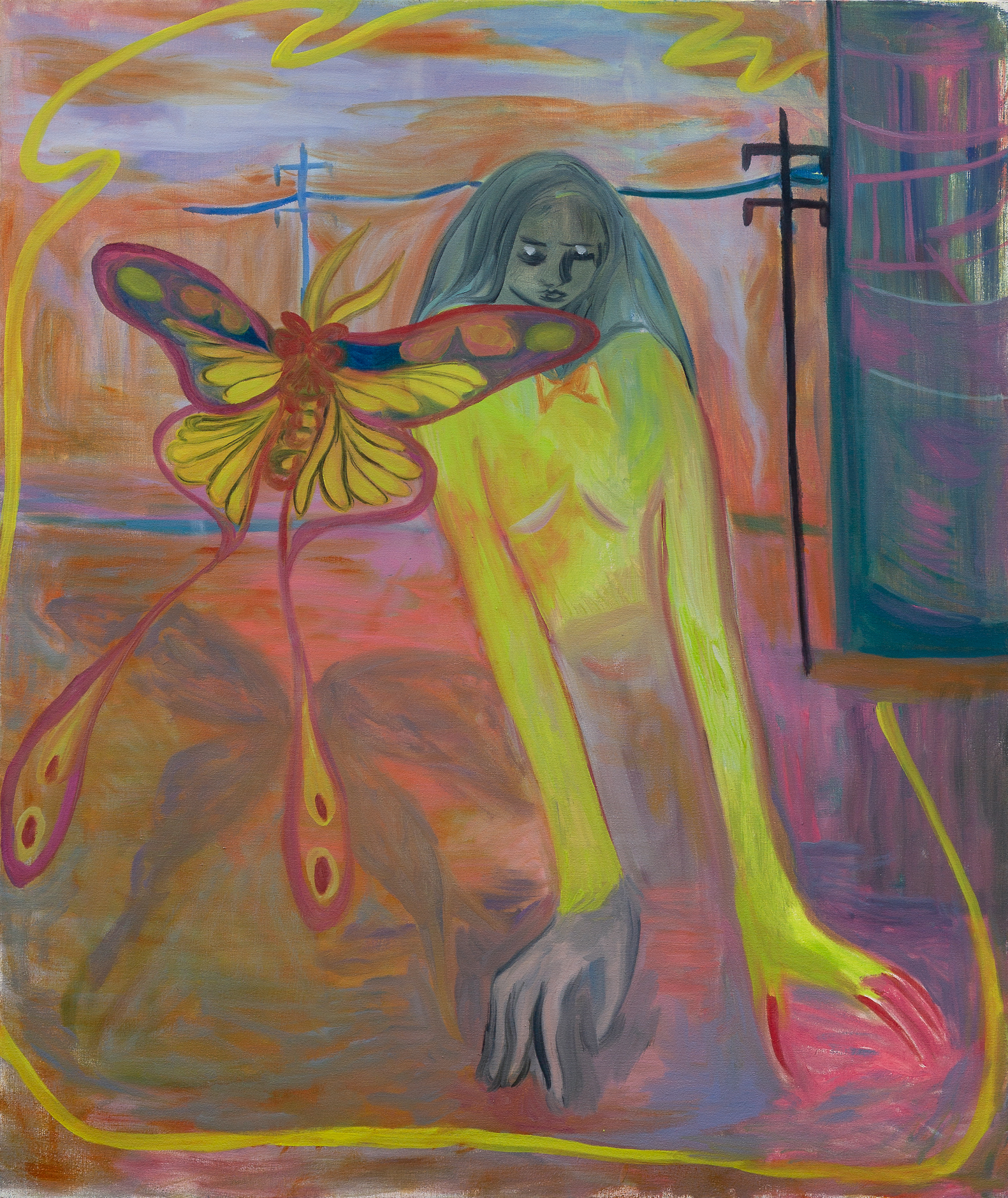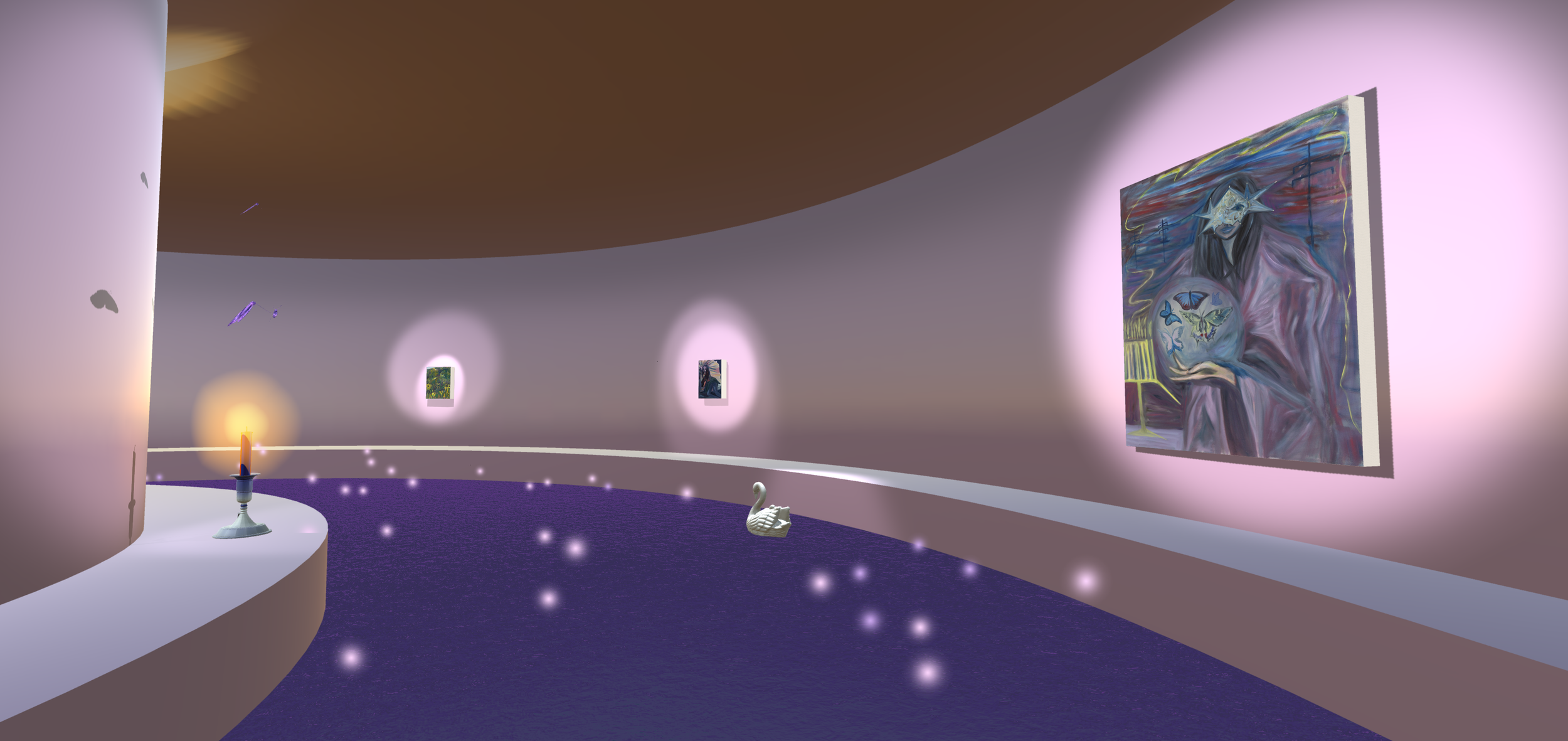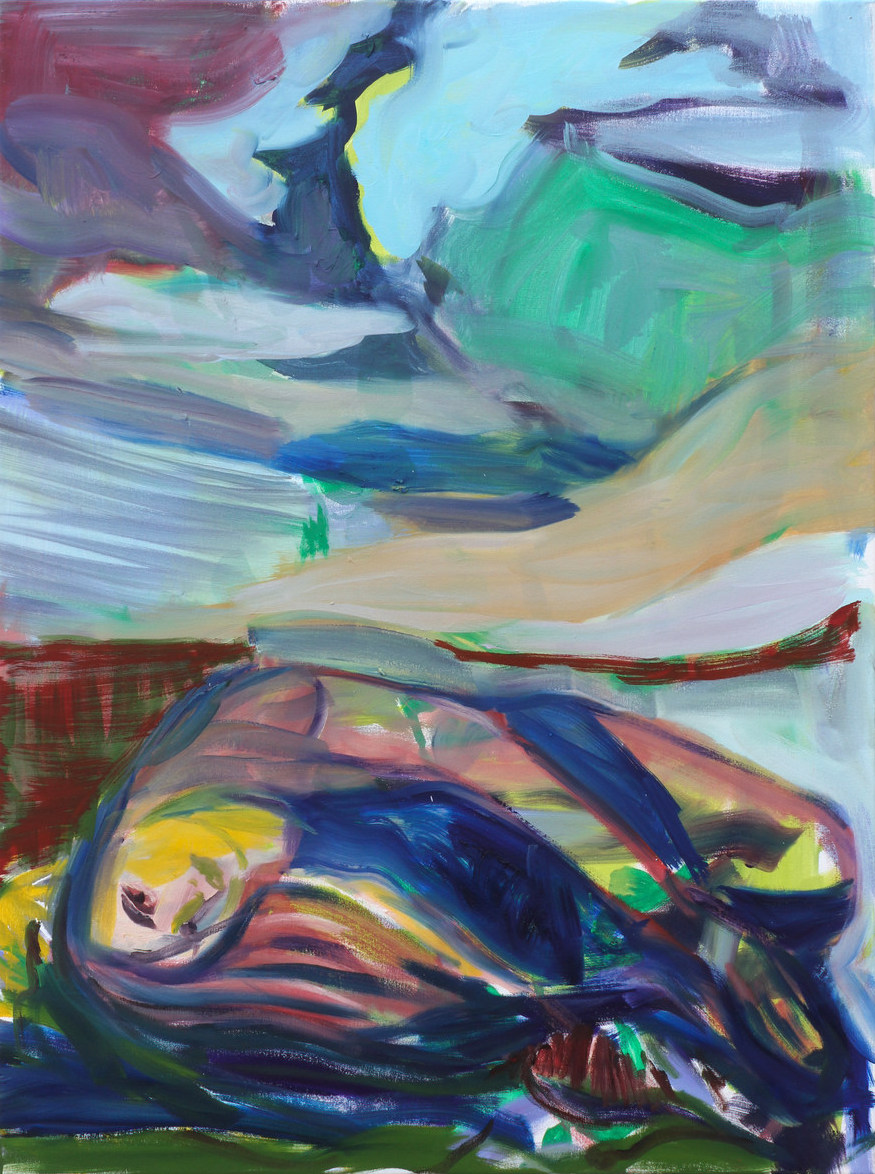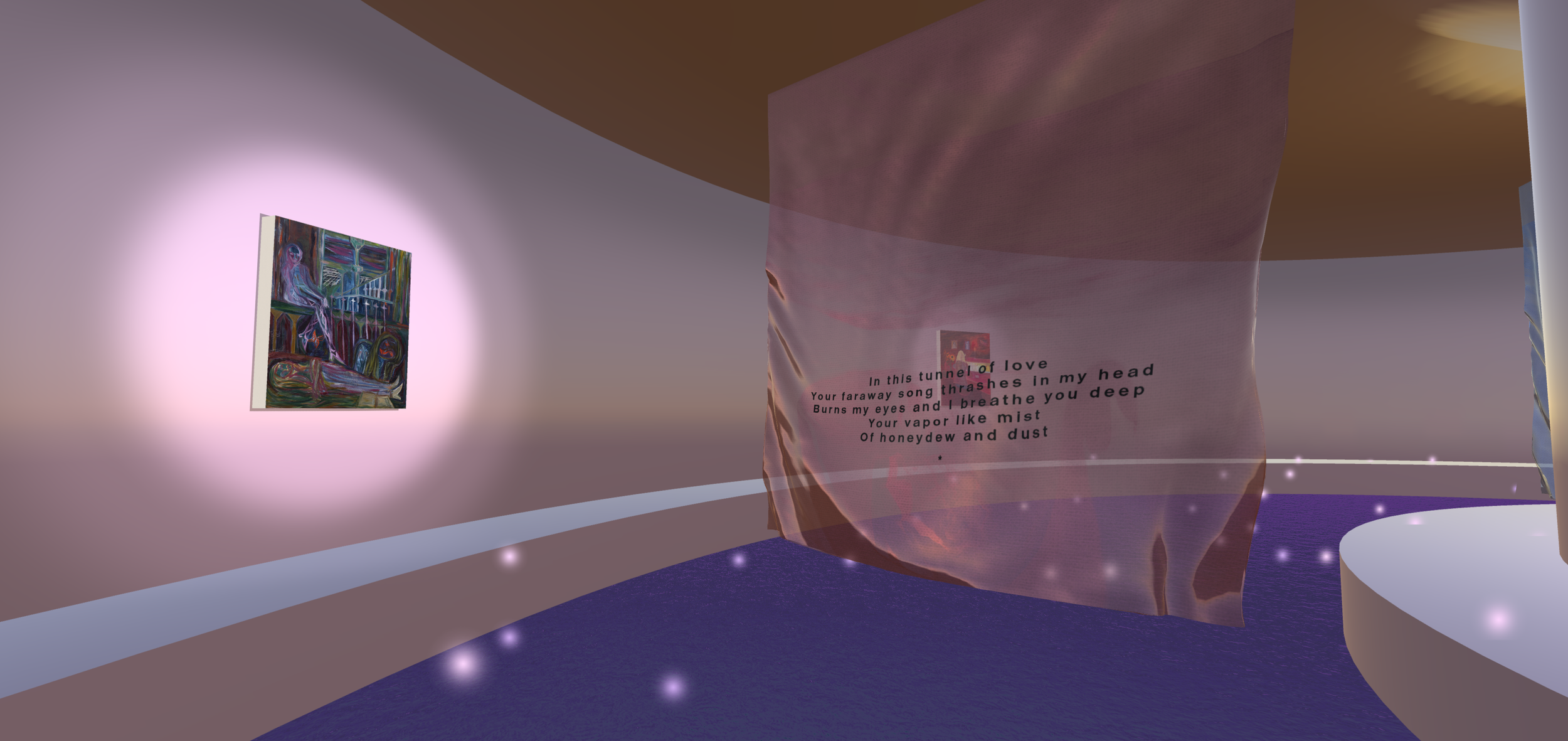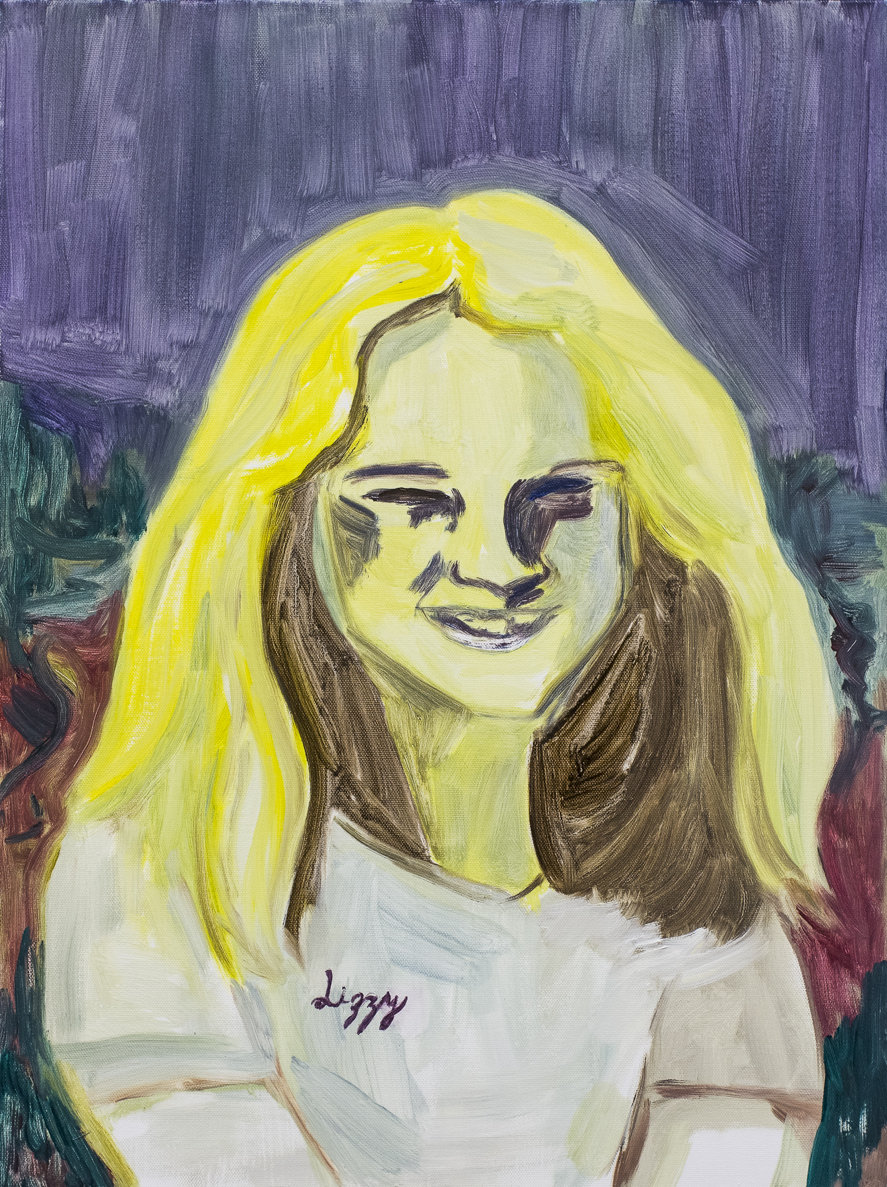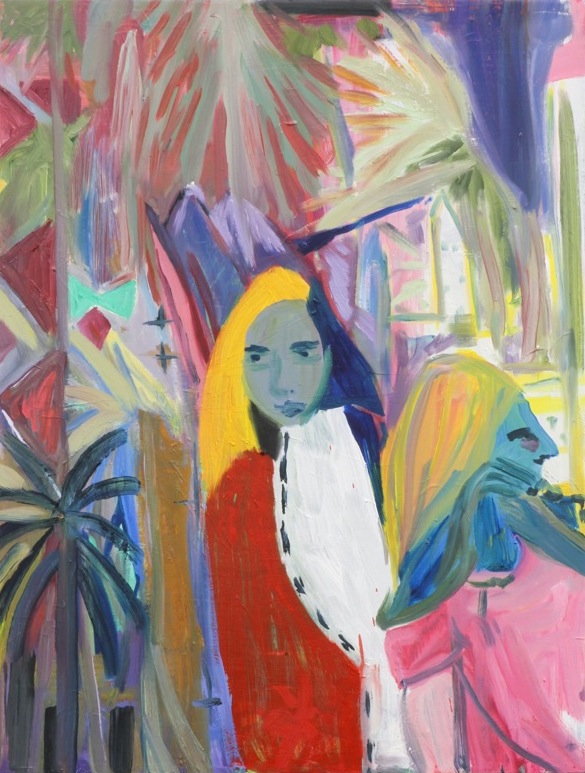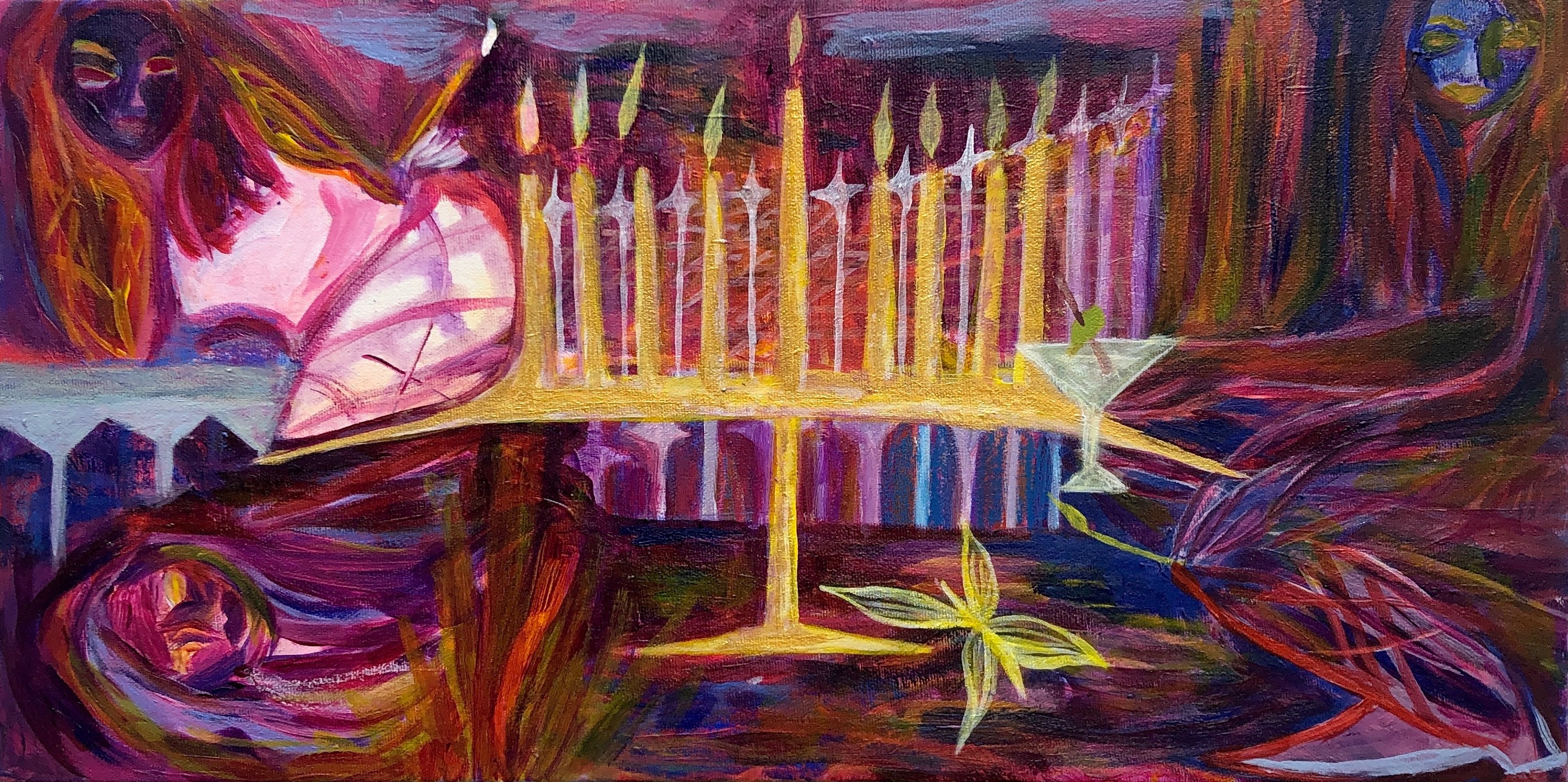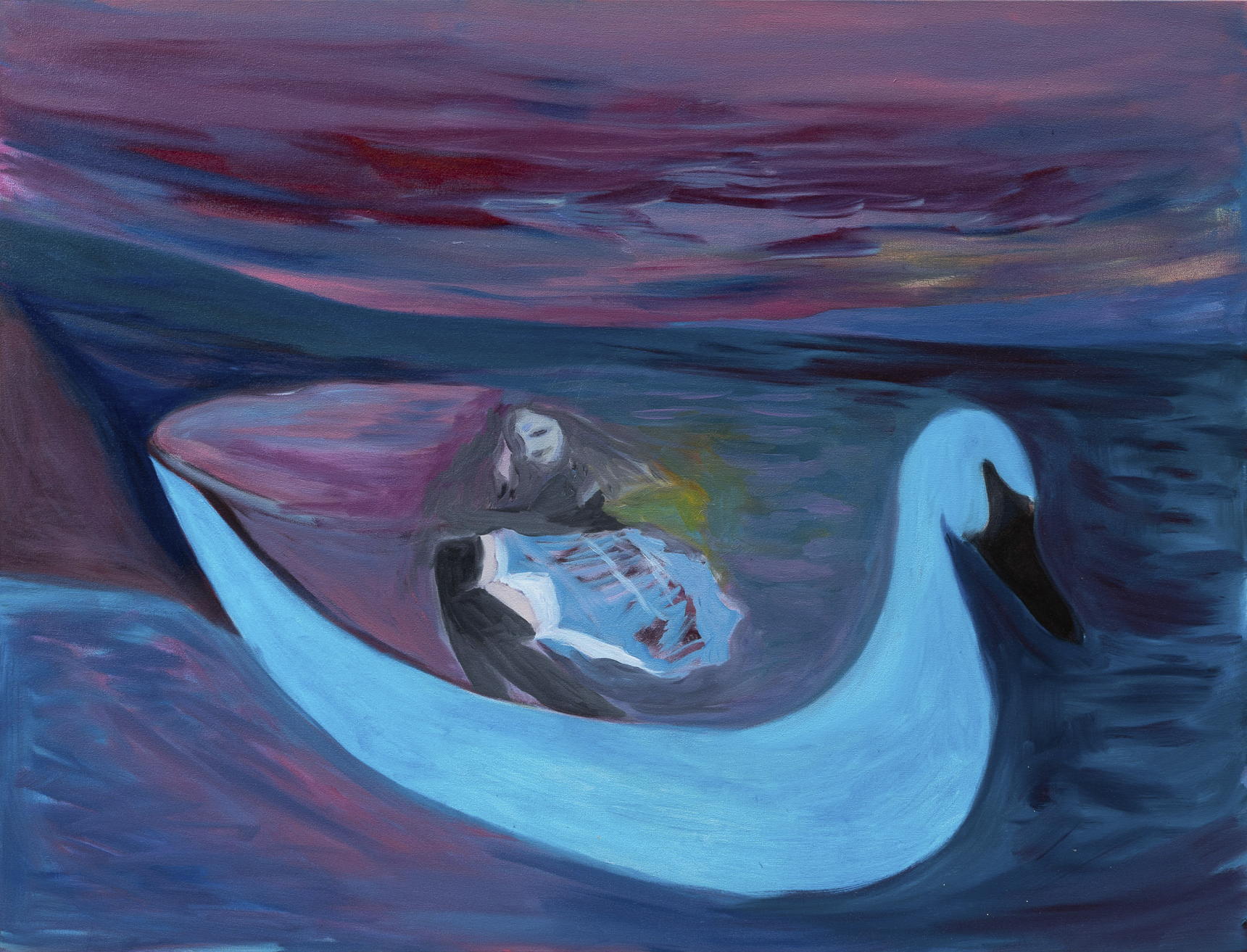Los Angeles-based painter Jessica Williams limns the intersection of the mystical and urban.
We spoke to Williams about being the fourth generation of her family in LA, the pyschologoical landscape of the city’s most banal sites, the power of narrative structures, and who her effervescent figures are.
![]()
The Phoenix,
oil on canvas, 32 x 38 inches
Do you have a rose and thorn for the week?
Right now and for the past few weeks, Los Angeles has been emerging from the shadowy pandemic world and that's been really interesting. I’ve been feeling like the sun has been almost blinding some days, the brightness has been so crazy lately. But I'm not sure if that's just part of my psychological re-emergence and this full experience of not being confined anymore, you know, and also just having somewhat of a social life again and seeing people’'s faces in person again. That would be my rose. I guess my thorn is this obfuscation that's been going on with social media and the state of our world of discourse.
I’m looking at your online show at Projet Pangee [“Tunnel of Love,” 2021], you mentioned that it's related to the pandemic. What’s this connection between the nocturnal, isolation, and the pandemic?
That's a cool question. During the pandemic I'd been doing lots of watercolors in my bedroom and was constantly in my house, staying up late, and feeling super isolated, so it was a natural extension to conceptualize an exhibition that reflected the experience of the world feeling like it existed somehow in the shadow of itself. Life felt completely surreal and apocalyptic.
That was the conceit in the beginning of working on Tunnel of Love, was this relationship to a nocturnal world within which the viewer would move through virtually, in a closed loop that sort of felt the way that time was operating. That was you know, that was kind of where these ideas started.
That was the conceit in the beginning of working on Tunnel of Love, was this relationship to a nocturnal world within which the viewer would move through virtually, in a closed loop that sort of felt the way that time was operating. That was you know, that was kind of where these ideas started.
![]()
Tunnel of Love, 2021
How did it feel to have a virtual exhibition, given that your work seems to be oriented around specific sites, whether those are emotive, public, or private?
It was interesting for sure. I imagined the viewer floating through the space to view the paintings on a swan boat, a nod to both the familiar kind of background scenery at Echo Park Lake and also a throwback to the swan boat Tunnel of Love rides, originally from the 1950’s.
It was very much a collaboration with the 3D designer in Montreal with Projet Pangee, Katerine, and she's never been to LA, so I felt like there was a lot of me trying to communicate the sensory experience like the colors and landscapes of my life and also in my paintings.
I was trying to get inside that memory space with this show. With the windows specifically, I wanted the viewer to look out on this kind of a pop-y, galactic, fiery scene, with all this haziness and smog.
It was very much a collaboration with the 3D designer in Montreal with Projet Pangee, Katerine, and she's never been to LA, so I felt like there was a lot of me trying to communicate the sensory experience like the colors and landscapes of my life and also in my paintings.
I was trying to get inside that memory space with this show. With the windows specifically, I wanted the viewer to look out on this kind of a pop-y, galactic, fiery scene, with all this haziness and smog.
You made all of the works for your show, “Only Girl In The World” (2015) at Young Art in LA, with a projector in a dark room. Can you talk about this interest in light and how it relates to color and this idea of non-physical space?
During this time I was looking at a lot of work by El Greco and Odilon Redon, two painters drawn to the dreamy depths and who were hyper experimental with color and light. Their paintings have a kind of ambient tension that I felt really connected to during that time.
For Only Girl in the World, I wanted to create my version of a Hollywood spectacle, an environment that had a strong aura but that felt crisp and not too nostalgic. I covered the gallery’s fluorescent bulbs with pink gel filters so that the gallery was either soft pink or electric pink, depending on what time of day people visited the show. And all of the work for the show was painted at night, with a projector in the dark as you mentioned.
What I was doing was trying to get into this tertiary color space, and psychic space, I guess, which is really related to what I was just talking about, it's this filtering of experience so that it's like many images and memories forming simultaneously within the paintings.
For Only Girl in the World, I wanted to create my version of a Hollywood spectacle, an environment that had a strong aura but that felt crisp and not too nostalgic. I covered the gallery’s fluorescent bulbs with pink gel filters so that the gallery was either soft pink or electric pink, depending on what time of day people visited the show. And all of the work for the show was painted at night, with a projector in the dark as you mentioned.
What I was doing was trying to get into this tertiary color space, and psychic space, I guess, which is really related to what I was just talking about, it's this filtering of experience so that it's like many images and memories forming simultaneously within the paintings.
![]()
Your Favorite Girl (After El Greco), 2015,
oil on canvas, 30 x 40 inches
Do you typically work from photos?
I have a lot of photos around my studio, like an archive of source material to work from, more as a basis for an image and then inevitably the painting will go off its own way. If I work from photos I’m not trying to depict the image but more of an atmosphere or feeling. Lately though I’ve been working more from my imagination or from life. I like to paint in Elysian Park which is right near my house. And then I’ll go into the studio and have the drawings or watercolors as a starting place.
You wrote the text for “Tunnel of Love” (2021) at Projet Pangée? What kind of interaction were you striving for between the text and the visual aspect?
I wanted the text, which I thought about as poems, to almost operate like reverb. I wanted them to operate like a faraway song that you heard, you know, like out of your car window, because you can't quite see the totality of the poems themselves as you’re moving through the virtual space, but maybe you remember a few of the sentences and they create an aura.
There’s this sense of building the experience through this kind of fragmented, always in-the-midst picture taking shape. There's a wind within the environment and illuminations that reflect or sparkle, so there's this layering of surfaces and sensory details.
There’s this sense of building the experience through this kind of fragmented, always in-the-midst picture taking shape. There's a wind within the environment and illuminations that reflect or sparkle, so there's this layering of surfaces and sensory details.
![]()
Tunnel of Love, 2021
“I wanted them to operate like a faraway song that you heard, you know, like out of your car window, because you can't quite see the totality of the poems themselves as you’re moving through the virtual space, but maybe you remember a few of the sentences and they create an aura.”
The figures in your paintings often blend into the landscape or background. Does this have a relationship to what you are saying about being enveloped in space?
Definitely, I feel like all of these ideas about transcendence through landscapes, and depicting an expansive or mystical consciousness, and this idea of obfuscation, that there's a hidden subject. I’m trying to access or get within those ideas, those themes of memory and transformation.
As I look at the figures in your works I wonder who they are.
I feel like they are all part of an imaginary film I’m directing. Are there any paintings in particular that you're thinking about?
I'm thinking specifically of the 2018 Orsini paintings.
Have you guys been to LA?
No; yes.
Oh, man. Okay, so these condo-plexes are really insane. They're these quasi-classical-Renaissance environments, but they're massive, and right off the freeways.
So first there's their visibility, the balconies are literally right on top of the freeways. They’re all named after Italian nobility, like the Orsini, the Medici, with this insinuated history and grandiosity, and at the time, I was really fascinated with them just because it doesn't look like anyone's actually living in them.
They're just these fortresses of isolation, solitude, but also projection because of their location in the city and their complete obtuseness–they just don't fit whatsoever.
So first there's their visibility, the balconies are literally right on top of the freeways. They’re all named after Italian nobility, like the Orsini, the Medici, with this insinuated history and grandiosity, and at the time, I was really fascinated with them just because it doesn't look like anyone's actually living in them.
They're just these fortresses of isolation, solitude, but also projection because of their location in the city and their complete obtuseness–they just don't fit whatsoever.
![]()
Orsini Dream No.2,
oil on canvas, 48 x 60 inches
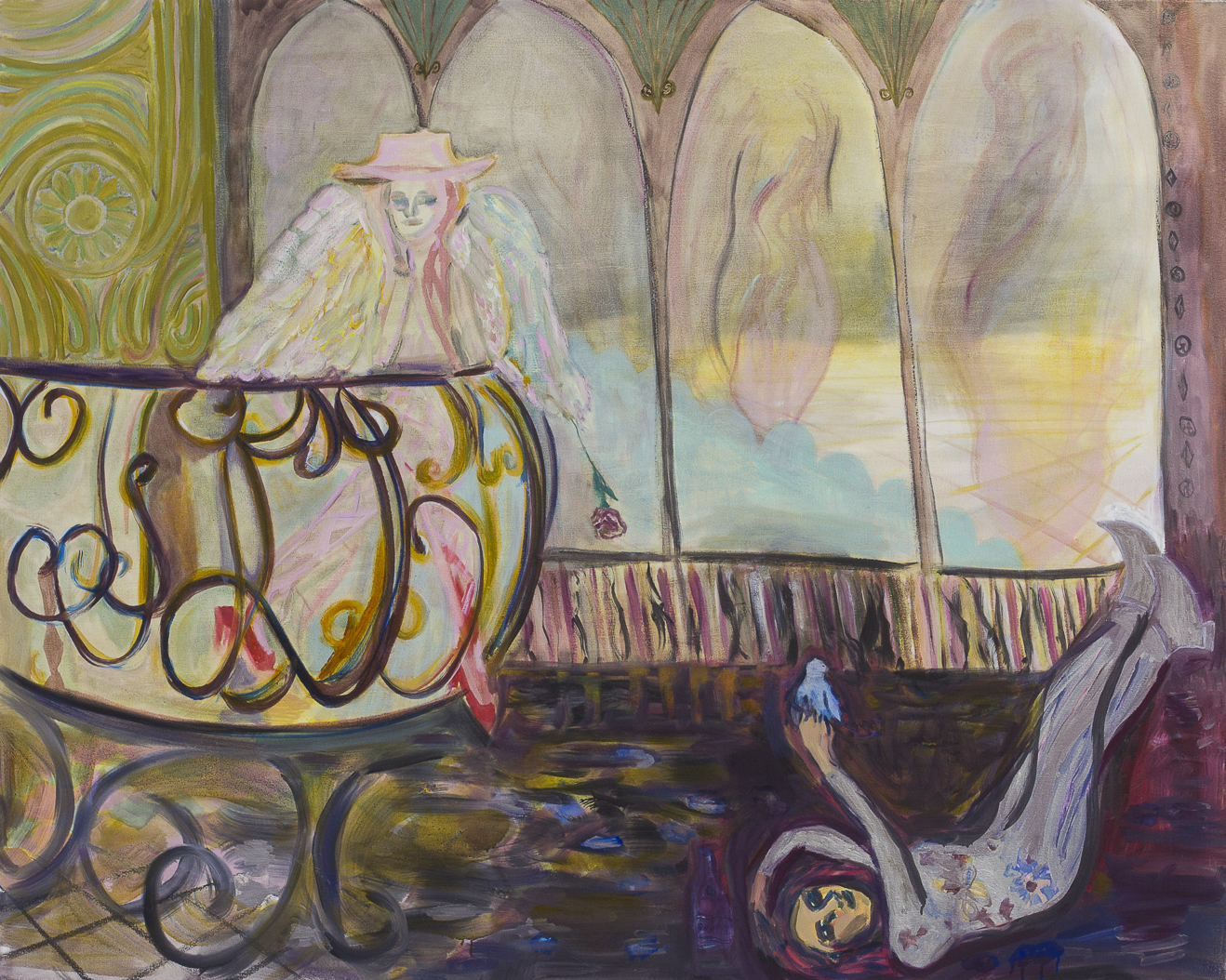
Orsini Dream No.2,
oil on canvas, 48 x 60 inches
“One of the best things I would say about LA, is just this relationship between architecture and psychology, a complete collision of people's ideas of self, or their idealized selves.”
So I had begun painting these figures, these girls out on the balcony, and staging them almost like plays. I was imagining putting a show in there or having a poetry reading in one of them, which was the beginning of the series, but I also painted them on fire, you know, because there was actually a fire that burned one down, I think it was the Medici, in 24 hours or something.
LA architecture and the fantasy of it all is just deranged. One of the best things I would say about LA, is just this relationship between architecture and psychology, a complete collision of people's ideas of self, or their idealized selves.
This makes me think of your Carrie Fisher and Lana Del Rey portraits, that idea of fantasy, fame and LA. What was it that attracted you to that subject matter, whether it was more about these kinds of people as part of the psychological landscape of the place or is it something more specific about those people that you felt like match your other works?
All of my work goes back to this psychology of place, and how our identities are shaped through environments.
Specifically, with Lana, she traffics in the idea of the icon, the Madonna, or these archetypes that she shares. They become even more real than the real, they kind of transcend the artifice–it’s hyper reality, and it’s so LA. And the imagery she uses, it’s all connected through these illusions - Lana as Mona Lisa, for example.
I think growing up in the valley, so close to Hollywood but also for me kind of a world away, and also not having any connection to the film industry has shaped a lot of my sensibility in that there’s this element of artifice and performance that’s omnipresent. And so, in my work I want the historical references to be experienced through a new lens.
Specifically, with Lana, she traffics in the idea of the icon, the Madonna, or these archetypes that she shares. They become even more real than the real, they kind of transcend the artifice–it’s hyper reality, and it’s so LA. And the imagery she uses, it’s all connected through these illusions - Lana as Mona Lisa, for example.
I think growing up in the valley, so close to Hollywood but also for me kind of a world away, and also not having any connection to the film industry has shaped a lot of my sensibility in that there’s this element of artifice and performance that’s omnipresent. And so, in my work I want the historical references to be experienced through a new lens.
![]()
Young Lana as Mona Lisa,
water soluble oil on canvas, 16 x 20 inches
That leads me to another question about storytelling. Are these stories or narratives rooted in more archetypal stories, like the phoenix or even the Madonna, etc.?
In a sense, yes. I think the Phoenix is such a powerful kind of projective space. The idea of this quasi-human rising from the ashes–all powerful, all surviving, and transcendent–all through getting really close to complete destruction.
I've been doing a lot of writing about that, and about collapse and building back up, because I always basically destroy the painting, and the image almost emerges through this process of painting-over in order to view what's there through all of these layers that I built up.
So they're pretty process oriented, I would say. In my mind, it connects to the idea of this nearly destroyed subject that then rises, emerges, or takes shape. So yeah, it's something that thrives in the midst of a picture taking shape, essentially.
I've been doing a lot of writing about that, and about collapse and building back up, because I always basically destroy the painting, and the image almost emerges through this process of painting-over in order to view what's there through all of these layers that I built up.
So they're pretty process oriented, I would say. In my mind, it connects to the idea of this nearly destroyed subject that then rises, emerges, or takes shape. So yeah, it's something that thrives in the midst of a picture taking shape, essentially.
![]()
The Trance,
oil on canvas, 55 x 64 inches

The Trance,
oil on canvas, 55 x 64 inches
A lot of the photographs I've seen of yours seem like they’re from your phone. I imagine it's something totally of the moment, like you whip your phone out and snap a pic. What do you pull from these for your paintings?
And, as another prong of the question, did you start making art as a painter or photographer?
And, as another prong of the question, did you start making art as a painter or photographer?
About the phone pictures, I have about 25,000 images on my phone right now. I'm constantly taking photographs and there’s this belief that I have in the texture and nuance of my environment, and what I'm trying to get at in painting is somehow embedded there, you know, with me, in the form of these digital timestamps.
But, in a sense, I don't think that a lot of that makes its way directly into my work. I take tons of photos, for instance, of strip malls all around the valley where I'm from, or of pretty blinding light, where the image is basically annihilated except for little details.
The paintings are very far, I would say, from any direct translation of my photos, but I do feel like they're extremely important to my sensibility and the way that I think about, creating the pictorial in a way that I think can be thought of as narrative, but not quite a story. But yeah I did start as a painter. I went to LA County High School for the Arts and was in their visual art program.
But, in a sense, I don't think that a lot of that makes its way directly into my work. I take tons of photos, for instance, of strip malls all around the valley where I'm from, or of pretty blinding light, where the image is basically annihilated except for little details.
The paintings are very far, I would say, from any direct translation of my photos, but I do feel like they're extremely important to my sensibility and the way that I think about, creating the pictorial in a way that I think can be thought of as narrative, but not quite a story. But yeah I did start as a painter. I went to LA County High School for the Arts and was in their visual art program.
![]()
West Coast Strip Mall (Born in the 80's), 2014,
oil on linen
In an interview with i-D Mexico in 2016, you were asked about the importance of place in your work and you stated that you think of your paintings more as a state of mind than a place. Do you still feel that way?
I do. I definitely relate to that so much still, but I would say that the state of mind is very connected to the psychology of place, if that makes sense. That Mexico City show, Realm of the Real was really interesting because it was inside the vitrine of a bodega, and it was illuminated at night. I had painted the wall black behind my paintings. The paintings themselves were two self-portraits and two more photographic, actually, landscapes, one that I had painted from a photograph and one that I had painted from the memory of that painting, they were remarkably similar!
In any case, I guess this is something I haven't really talked about all that much in interviews, but it’s the idea I’ve internalized since childhood, within my Jewish identity, that the present is never fully present, it is a product of inherited time and inherited psychology, across generations, spanning time and memory.
In any case, I guess this is something I haven't really talked about all that much in interviews, but it’s the idea I’ve internalized since childhood, within my Jewish identity, that the present is never fully present, it is a product of inherited time and inherited psychology, across generations, spanning time and memory.
![]()
The Hanukkiah,
acrylic and pastel on linen, 10 x 20 inches
It feels like your work dealing with the body and nature versus the body and objects uses the same kind of language in talking about how we relate to those things.
Yeah, it's very metaphoric, I feel like I changed the aspect of nature and I made metaphors with objects instead. It feels like the same language still, right.
There's like an interesting play between interiority and exteriority in your work which I think relates to this. There’s the motifs of balconies and windows. Can you talk about what interests you here?
And mirrors, too, and if I'm painting a mirror and it's maybe kind of illegible, it might be thought of as a window.
They're both interesting, this idea of the outward facing and inward facing and the expansiveness or this sort of rupture between reality and the imaginary or that space of projection within our own identities and of seeing oneself, presenting oneself, that goes back to the portraits of Lana when she was young, or Lana as the Mona Lisa.
I imagine these moments of seeing oneself in the other or in the object of effect, in art, in the world, and then adorning it or bringing it back to oneself. These ineffable psychological junctures that we all have that are immaterial. I try to find my ways through portraiture, landscape,and still life in order to articulate that.
They're both interesting, this idea of the outward facing and inward facing and the expansiveness or this sort of rupture between reality and the imaginary or that space of projection within our own identities and of seeing oneself, presenting oneself, that goes back to the portraits of Lana when she was young, or Lana as the Mona Lisa.
I imagine these moments of seeing oneself in the other or in the object of effect, in art, in the world, and then adorning it or bringing it back to oneself. These ineffable psychological junctures that we all have that are immaterial. I try to find my ways through portraiture, landscape,and still life in order to articulate that.
![]()
Poetry at the Orsini, 2018
oil on canvas, 48 x 60 inches

Poetry at the Orsini, 2018
oil on canvas, 48 x 60 inches
“I imagine these moments of seeing oneself in the other or in the object of effect, in art, in the world, and then adorning it or bringing it back to oneself.”
What's next for you? Is there a direction you'd like to go in? Is there a project that you wish you could bring to fruition?
I'll be showing work in a group show coming up on August 13th at False Cast Gallery, they are going to do a pop up here in LA. They’re based in San Diego.
I just exhibited my first sculptural installation with Los Angeles Nomadic Division, which was curated by my friends Perwana Nazif and Julia Leonard and opened June 5. All of the works were installed and suspended in some form at LA Historic Park in Chinatown. I created these butterfly and floral forms out of paper mache, installed on a wire armature so they looked like they were floating.
I just exhibited my first sculptural installation with Los Angeles Nomadic Division, which was curated by my friends Perwana Nazif and Julia Leonard and opened June 5. All of the works were installed and suspended in some form at LA Historic Park in Chinatown. I created these butterfly and floral forms out of paper mache, installed on a wire armature so they looked like they were floating.
Are you interested in continuing to work in sculpture? It feels really complimentary to this idea of place and environment.
Yeah, so this material that I was using at first, I was using this kind of like plasticine that never dries. And then it was kind of like, it had too much weight to it. And then I wanted to do paper mache but my mind is like, I'm extremely, it's very 2D. Um, and I was having a lot of trouble with like, you know, the balloons and the just the craft of it. Like, I felt like it was too sloppy. And I found this material that essentially you just add water to a material like pulp. And so I'm just it's, you know, I'm sculpting it like ceramic. And I've been having, it's been really, really interesting. So yeah, I do think I'm going to be doing more of that for sure.
![]()
Dreaming Diva, 2021
oil on canvas, 34 x 40 iinches
Well now I want to go to LA.
Do my paintings make you want to come here? And do they feel specifically LA to you?
I don't know how you feel about Joan Didion, I don't necessarily love her, but she has a very deadpan view of LA, which I feel like your paintings also possess. They cut through the bullshit in the same way. I want to visit.
That's major. I'm a huge Joan Didion fan. The “Los Angeles Notebook” has been a primary source that I return to. When she says “the city burning is Los Angeles’s deepest image of itself,” it’s like this very icy clarity, and vision of the apocalypse. She also writes about the Santa Ana winds and the ambient anxiety they induce. In my work I want to make myself and also the viewer feel free, within a kind of reverie.
Visit Jessica Williams’s artist page.
︎: @jessica___williams

